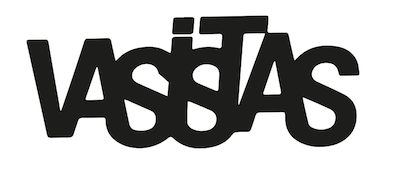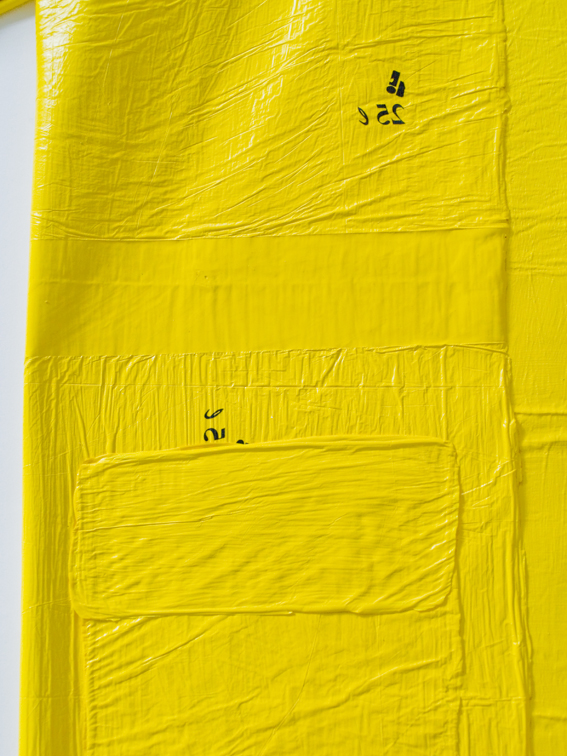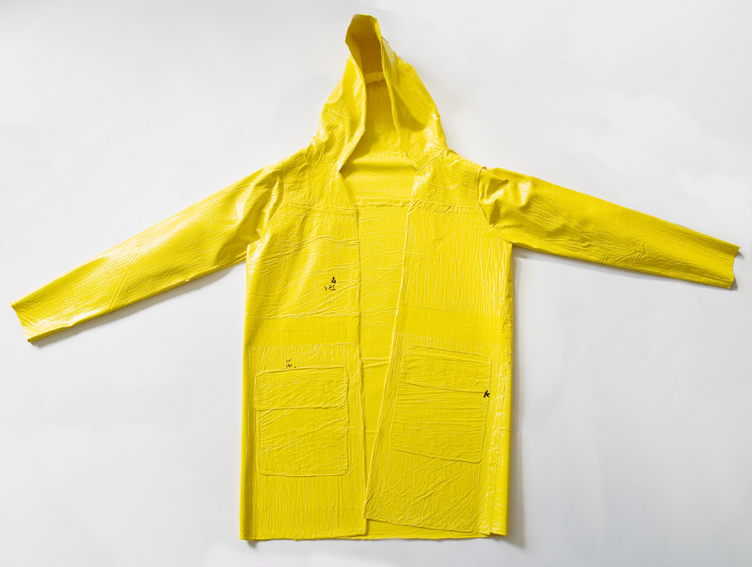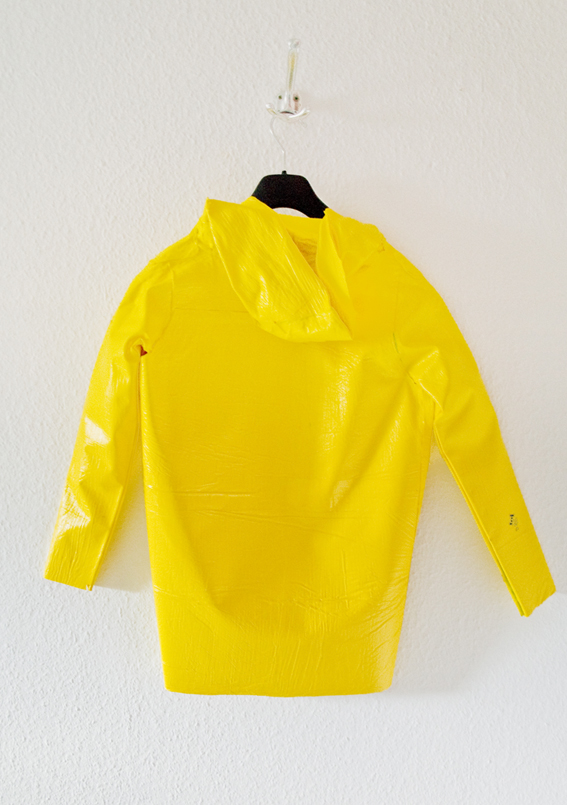Interview by Patrick C. Haas
Her painted objects each show each a distorted scenery which looks like an architectural space, and which can only be grasped after a long stare. But this is only a superficial decoration, which in its core questions the relation between painting and sculpture. Gruner painted those places on the inside of plastic bags which she then shaped layer- by- layer into a biscuit and an inflated potato chips bag, or a crushed chocolate truffle box. In the end the entire piece was made of acrylic paint. Thereforeis way the objects are the merely essence of a painting – the paint itself.
The young artist, who still studies at the Kunstakademie Düsseldorf in the class of Katharina Grosse, is, like her teacher, working on the subject of how image and space correlate, using mostly painting, but also objects, photography, digital images, performance and installation.
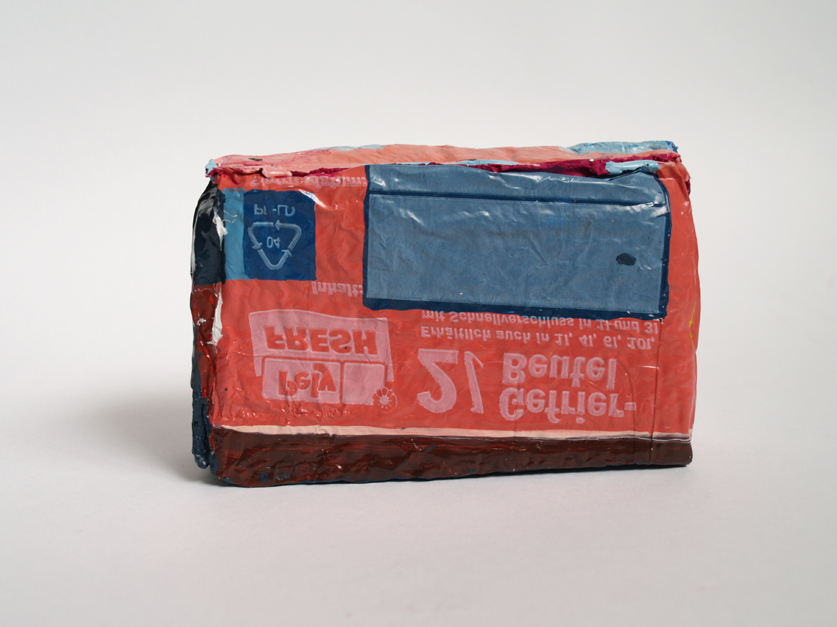
P :
I was really surprised when I first saw your work and a bit confused, to be honest, about the presentation. The table gave the pieces a weird atmosphere, because from afar it was impossible to tell if they are just painted bags or some kind of sculpture. But these are not your solely works that deal with every day objects that play with the context they are presented in. One of yourYour newest pieces, such as REGENHAUT (2014), or SENKE from 2012, deal with a distortion of the tromploei effect that those works inherent inherit in a first glance. Your works pretend to be, without being what you expect them to be. So REGENHAUT, in that sense, is imitating a girl’s medium size rain coat which was randomly presented on a window knob in the main conference room. Were you happy with the presentation? And what made you choose to produce this object, because other works of yours are way more abstract in their visual codes?

J :
I gave instructions how my works should be placed – not on a pedestal at best integrated in the existing furniture. As you said, they appeared on this glass table with this strange leather couch which made me very happy, because they looked so artificial but familiar at the same time. This created a really weird effect, that you felt like you know them from somewhere and as if you could open them up and eat the sweets! This applies to the three objects as well as the rain coat piece. REGENHAUT, on the other hand, is a crux, since you can see it as a monochrome yellow painting, as well as an object or even as a real rain coat, since you could actually wear it and dried acrylic paint is waterproof. So the boarders between painting/object and art/everyday life object are blurred.
The visual codes of other – in its essence – more abstract works are results of experimenting with the image itself.
The visual codes of other – in its essence – more abstract works are results of experimenting with the image itself. They are computer manipulated microscope images that investigate painting – or paint, pigments – itself, by blowing up details of very thin layered pieces of dried spray paint so much, that later on the printed photograph, which is later glued to the wall, becomes something changing between abstract image and an illusion of an actual hole in the wall.
P :
So the upscale version of a spray paint detail on the wall of the show at STARTER (Poland, 2014) is, I think, a great example for that series that pushes the image – especially through the placement high up the wall – in a state that detracts it from the viewer’s gaze and analysis, so that, because you have to look from afar, can not tell the difference between print or paint at all. The Iillusional seems to be import ant for you?
J :
I like to play with dimensions. Objects that appear to be three dimensional but are not. The placement in an exhibition or any kind of space that this work could be seen, is therefor of utmost importance. To seduce the viewer into a dimensional play whereby, when you look at painting, you barely question the depth. We perceive perspective and stereoscopic depth in painting as something natural, but this series does not reproduce any real dimensions. They are details, clippings of something bigger, thus they are just layers of pigment representing only itself and the play with the change of colour.
Julia Gruner shows us the blurry line between categories, terms and definition of “things”, which we used to be able to identify at first sight. Her pieces constantly shift from the abstract or figurative, art or everyday object, painting, sculpture or photography to the opposite. Most of them are everything at the same time, but none to begin with. Her pieces are not paintings, but paint. Less in the sense of Radical Painting, where paint is material, but a painting from paint and therefor it becomes a sculpture. and Iin this line of work she uses the spatcial dimensions and the proportion of our own body to lead us to conclusions about our own perception. These objects of paint/art are imitating, or camouflaging, themselves as everyday objects so that pieces at Hogan Lovells were focused on the aspect of painting, sculpture and how we perceive them in a given environment.
We are looking forward what Julia Gruner is going to do in the future. You can follow her by visiting her website: www.juliagruner.com or visit the upcoming group show at KIT (Düsseldorf, 2014/29/11 – 2015/15/2).
Interview by Patrick C. Haas
All images courtesy of the artist.
